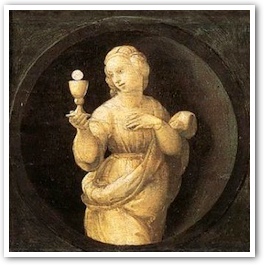The Catholic Doctrine of the Real Presence
- REV. KENNETH BAKER, S.J.
According to Catholic belief the Holy Eucharist is both a sacrament and a sacrifice. The aspect of the sacrament which I will consider now is what is known as the "Real Presence".
 |
By this expression is meant that the true Body and Blood, soul and divinity of Christ are really and substantially present under the Eucharistic species, that is, the appearances of bread and wine which remain on the altar after the Consecration.
"Presence" is one of those basic realities which we all experience and all know, but which is difficult to describe and define. Basically it means "being at hand", "being in front of"; when it is said of persons, often it also has the added meaning of "being for" or "being with", in the sense of accompanying someone.
A moment's reflection will reveal that God is present to us in a number of ways. By his power he is present in all of creation, since he conserves everything in its being. He is present in the souls of the just by his sanctifying grace. He is present in his Church which is the New Israel, the holy people of God. He is present in bishops and priests in a special way by reason of their consecration in Holy Orders. He is present, in a different way, in Holy Scripture and in the proclamation of his holy Word. These are some of the various ways in which God is present to his people.
But when the Church says that the glorified Jesus is really present in the Holy Eucharist, she is talking about a different and very special kind of presence. She means that, by the almighty power of God, a stupendous miracle has taken place, namely, the substance and reality of bread and wine have been changed into the substance and reality of the Body and Blood of the resurrected Jesus Christ who is now seated at the right hand of the Father in heaven. Therefore, since Jesus Christ is God and God is worthy of adoration, it follows that the Lord, truly present under the appearances of bread and wine, is worthy of adoration in the Holy Eucharist. For this reason the Church surrounds the Mass and the Eucharist with various gestures of adoration, such as incense, bows, genuflections, silence, candles, formal liturgical clothing and so forth.
It is not difficult to show from history the unanimity of belief in the Real Presence of Christ in the Eucharist for the first 1500 years of the Church. Occasional doubts about it, such as those of Berengarius of Tours (d. 1088), caused an instant uproar - which attests to the universal acceptance of the Real Presence. This unanimous belief of 1500 years is itself an argument for its truth. For it is impossible that the Holy Spirit could leave the Church in error over a long period of time about one of the central doctrines of Christianity.
Widespread doubts about, and denials of, the Real Presence appeared in the sixteenth century. The Protestant Reformers were unanimous in rejecting transubstantiation and the sacrificial character of the Eucharist, but they did not agree on the question of the Real Presence. Thus, Luther admitted it but then added that it occurred only during the celebration of Holy Communion. Zwingli, along with many others, simply denied the Real Presence and claimed that the bread and wine are mere symbols of the Body and Blood of Christ. Calvin (later joined by Melanchthon) rejected the substantial or real presence of the Body and Blood of Christ and taught a presence of "power", that is, through the Eucharist a power proceeds from the glorified Body of Christ in heaven and is conferred on the faithful.
Because of the denials and doubts of the Protestant Reformers about the Mass, the Eucharist and the Real Presence, the Council of Trent (1545-1563) took up each of these questions and laid out for all the official, infallible teaching of the Church. Thus, in response to Zwingli, Calvin and their followers, the Council declared: "If anyone denies that the body and blood, together with the soul and divinity, of our Lord Jesus Christ and, therefore, the whole Christ is truly, really, and substantially contained in the sacrament of the most holy Eucharist, but says that Christ is present in the Sacrament only as in a sign or figure, or by his power: let him be anathema" (Denzinger-Schunmetzer 1651).
 This is Meaghen Gonzalez, Editor of CERC. I hope you appreciated this piece. We curate these articles especially for believers like you.
This is Meaghen Gonzalez, Editor of CERC. I hope you appreciated this piece. We curate these articles especially for believers like you.
Please show your appreciation by making a $3 donation. CERC is entirely reader supported.

Acknowledgement
Kenneth Baker, S.J. "The Catholic Doctrine of the Real Presence." In Fundamentals of Catholicism Vol. 3 Part 3, Chapter 23 (San Francisco: Ignatius Press, 1995), 229-231.
This article reprinted with permission from Father Kenneth Baker, S.J.
The Author

 Father Kenneth Baker, S.J., assumed editorship of Homiletic & Pastoral Review in April 1971 and remained in this position for almost forty years. In 1983 he published a three-volume explanation of the faith called Fundamentals of Catholicism Vol. 1, Creed and Commandments; Vol. 2, God, Trinity, Creation, Christ, Mary; and Vol. 3, Grace, the Church, the Sacraments, Eschatology
Father Kenneth Baker, S.J., assumed editorship of Homiletic & Pastoral Review in April 1971 and remained in this position for almost forty years. In 1983 he published a three-volume explanation of the faith called Fundamentals of Catholicism Vol. 1, Creed and Commandments; Vol. 2, God, Trinity, Creation, Christ, Mary; and Vol. 3, Grace, the Church, the Sacraments, Eschatology




